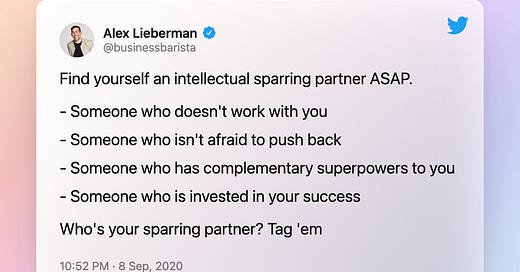#53 Chaos Monkey, Ramen Profitability, Dall.E 2
Learning from Paul Graham, David Perell, Sahil Bloom and more
Founding Fuel’s daily post starts with a short book excerpt. They also add comments on how they find it interesting & relevant for their audience. I've tried to copy this format to many of the posts in this newsletter.
Today I'm taking liberty to take the opening section from one of their recent posts and put it as is for this group. It talks of a book (and author) who has inspired a lot of conversation in my immediate circle. This topic in discussion is very relevant for all. Solving for one is not an easy call. We’re trained to base our discussion on quantitative measures & customer research methods. Yet, the author's argument is solid and worth giving further thought.
Here you go with the snapshot from the post (highlights are mine)
Towards the end of his book Upstream: How to Solve Problems Before They Happen, Dan Heath shares a fascinating story behind the invention of the tennis ball hopper, which is used to pick up balls scattered around the court during and after practice. It was invented by a tennis coach by name Jake Stap who was frustrated by picking them up.
Heath writes: “Once you’ve bent over a few hundred times to retrieve balls, and suffered from the ensuing back pain, you’re ready for a better solution. So he put a tennis ball on the passenger seat of his car—to serve as a reminder of the problem—and as he drove around, he brainstormed solutions. What if I had an arm extender, he wondered, that would allow me to grab balls without bending over? No, that wasn’t quite right—it would still be laborious, handling one ball at a time. ‘Finally, during one of his meditations,’ wrote Pagan Kennedy in Inventology, ‘Stap reached over and pinched the tennis ball on the seat next to him. When the rubber yielded under his fingertips, he had a new idea: the ball could squeeze through metal bars, taking a one-way trip into a wire bin.’
“And that’s how the familiar tennis ball hopper was dreamed into the world, born of back pain and irritation. Stap solved his own problem—and that of every other tennis player since.”
Behind the story lies an important insight. Heath points out that the macro in fact starts with the micro.
He writes, “When we think about big problems, we’re forced to grapple with big numbers. What would it take to solve problems for 1,000 people? Your first instinct might be to say: We’ll have to think about the big picture, because we can’t very well intervene individually with 1,000 people. But that notion, as it turns out, is exactly wrong… You can’t help a thousand people, or a million, until you understand how to help one. That’s because you don’t understand a problem until you’ve seen it up close.”
The takeaway: Heath writes, “If you want to help solve big problems in the world, seek out groups who have ambitious goals coupled with close-up experience.”
And with that, let’s move to the interesting reads for today.
1. Storytelling, JDs & Strategy
Prof. Saral Mukherjee would often quote in his class - “Strategy is the art of closing doors.”
The choices you make about not pursuing something are very important. They are often not discussed further to the point of the decision. But, they have the power to show a lot more about your way of thinking & decision making. They are great examples to showcase how your product & org values come to play in real life.
“Good Leaders are Great Storytellers” has a bunch of useful insights on storytelling. But this one stuck with me the most.
Remember your story isn’t for everyone. “Most job descriptions aren’t actually very honest,” says Graham. “They’re written so that everyone will read it and think ‘Yes! I am definitely qualified to do that. I want that job!’” This happens because job descriptions are written like pitches, practically selling the idea of the job to prospective candidates. “I once got some amazing advice to write your job description for the one person that should absolutely 100% be in that role,” she says. “You want everyone who isn’t right for the job to think, ‘Oh my god, I definitely don’t want that job.’ The same is true of your company's culture narrative: When you have a well-crafted, specific, controversial company story, it can guide everything from who you shouldn’t hire to how you settle arguments.”
It's a very inconvenient way to look at things - one that creates more roadblocks than enablers. This is the ‘art of closing the door' part. The immediate outcome seems more unfavorable and the real benefit only occurs later. It’s the bitter pill - tough one, but worth considering.
2. Chaos Monkey
Sketchplanations recently talked about Netflix’s chaos monkey system.
As Netflix defines it, Chaos Monkey is responsible for randomly terminating instances in production to ensure that engineers implement their services to be resilient to instance failures.
Kudos to the engineer/team that came up with this! It’s not easy to disrupt yourself or plan to administer such painful events. However as Sketchplanations highlights.
It takes the pain of disappearing servers and brings that pain forward. By deliberately sabotaging their own systems it created strong alignment for the team to design-in redundancy and automation for the necessary resiliency and reliability in the face of random failures.
If you had to imagine such a system in place, what areas beyond safety/security come to your mind?
3. Learning plans
In “Learn like an athlete” David Perell recommends implementing “learning plans”. According to him, top athletes are clear in their objectives and deliberate in their pursuit of improvement.
If we put a similar approach in our learning, we can also create a learning routine like athletes train. Here’s a quick tip or two around how to build effective learning plans.
I like Daniel Gross’ framework for learning. When I interviewed him, he told me to build a video game for myself. Like a video game, productive projects have multiple levels. They follow the Goldilocks Principle: not too easy, not too hard. The learning project needs to be challenging enough to demand focus, but easy enough to make consistent progress. That way, you can enter the optimal state of learning.
4. Ramen profitability
Y Combinator and Paul Graham have defined a lot of terms used in startup lingo. Ramen profitability is one of those. Here’s how Paul Graham had defined it in his 2009 essay - “Ramen Profitable”.
Ramen profitable means a startup makes just enough to pay the founders' living expenses. This is a different form of profitability than startups have traditionally aimed for. Traditional profitability means a big bet is finally paying off, whereas the main importance of ramen profitability is that it buys you time.
He goes on to explain the benefits of this in this essay. There is no rocket science here, most observations seem common sense. But as they say, not all simple things are easy.
5. Intellectual sparring partner
Sahil Bloom shared the following definition in a recent post.
An intellectual sparring partner is a friend, colleague, or acquaintance whose combination of background, competency, and personality makes them well-suited to strengthen the quality of your reasoning and decision-making via active, grounded discussion and debate.
Here’s how Alex Lieberman defined and made it popular.
Call them this or otherwise, you must have had such colleagues or friends who have contributed significantly to your intellectual growth. If they were not your teacher or mentor, then they are your ISPs. Find one, keep them close to you. There are no better punching bags for fine tuning good ideas.
6. Reader's (web) world view
Starting today, I’m adding a new section based on Siddhant’s suggestion.
This - “Reader’s (web) world view” - will cover articles that you recommend & share with me for this audience. Our idea will be to expand the topic of interests and explore more with the help of this group. There are lots of non-overlapping interests in this group. It's time to scratch the surface of some of those. So go ahead, send across your recommendations with a brief note for this group and I will do the needful.
And with that, it's over to Siddhant's recommendation.
Did you check out Dall-E? It is a new AI demo released by Open-AI last week which can generate art by a prompt. For example, if you give it a prompt like:
“A Shiba Inu dog wearing a beret and black turtleneck”
it generates:
Check out this twitter thread for more examples and the website for some interactive demo. This is leaps ahead of previous results from various different teams because it is very photorealistic -- making it easier to pass the turing test.
My comments: This is really exciting stuff on the AI front. GPT3 earlier and now this - AI is entering territories that were considered more right-brained. There’s still some time before AI replaces humans in these fields (if it ever), so for now, let’s celebrate these early wins!
7. Everything else
Some random goodness from the internet:
Creative projects: Occlusion Grotesque is an experimental typeface derived from a project that explores what it means to design with nature and on nature's terms.
Twitter: A thread capturing beautiful words of wisdom from 84 year old Kurt Vonnegut.
Web: Mechanical Watch is a beautiful example of how engaging content can teach you complex subjects in a fun way.
Interesting reads: His software sang the words of God. Then it went silent (we don’t know if we will ever revive this), Good ideas stick (bonus: story of washi tapes)
Before we sign off, here’s a small tip if your twitter timeline is cluttered with those clickbait-ish threads telling the same set of ‘inspirational stories’.
Go to Setting > Privacy and safety > Mute & block > Muted words (Or alternatively - go to https://twitter.com/settings/muted_keywords in your browser)
And add the following to “Add muted words” - 1/n, 1/x, thread, 🧵
It just feels tough, FOMO is really strong. But trust me, you will thank me later.
That's all for this week, folks!
If you enjoyed this post, show your love by commenting and liking it. I write this newsletter to share what I learnt from others. If you learnt something from this today, why not share it with a couple of your friends to continue this chain?







Top quality stuff Pritesh. Keep writing :)